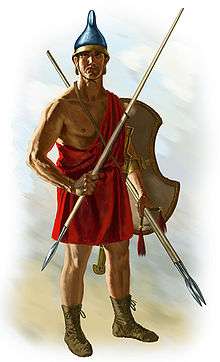Agrianes

The Agrianes (Ancient Greek: Ἀγρίανες, Agrianes, or Agrianoi) or Agrianians, were a tribe whose country was centered at Upper Strymon, in present-day western Bulgaria, and also held areas of southeasternmost Serbia in the ancient Roman provinces of Dacia Mediterranea, at the time situated north of the Dentheletae. In the times of Philip II, the territory of the Agrianes was administered by Pella. They were crack javelin throwers and an elite unit of Alexander the Great's light infantry, who fought under the command of General Attalus.
Etymology and tribal belonging
Their name in Ancient Greek was Ἀγρίανες.[1] The ethnonym is of Indo-European origin, from *agro- "field" (cf. Lat. ager, Gk. ἀγρός agros, Eng. acre).[2] An early name of the Rhodopes was Achrida, which may be a cognate.
Herodotus described them as a tribe of Paeonia,[3] together with the Odomanti and Doberes in the vicinity of Pangaeum. The only writer who describes the Agrianes as Thracians is Theopompus.[4]
Geography
Their country was centered at Upper Strymon, in present-day westernmost Bulgaria, and also held areas of southeasternmost Serbia,[5] at the time situated north of the Dentheletae. In the times of Philip II, the territory of the Agrianes was administered by Pella.[6] An ethnocultural region called "Graovo" remains in Pernik Province, along with a group of Pomaks with a similar name.[7]
Military

They fought light; they carried a bundle of javelins into battle and wore no armor or helmets, perhaps not even shields.[8] Alexander made heavy use of them and every time he dispatched a flying column, the Agrianians were always included. They were expert fighters in mountainous terrain where the phalanx was impracticable and mobile enough to use when speed was essential. Being an elite unit of the light infantry, they often formed up with the hypaspists battalion and the companion cavalry on the right wing of the army.
History
They are first mentioned regarding the Megabazos' campaign in 511 BC.[2] In 429 BC they were subject to the Odrysian kingdom[9] and later, as early as 352 BC, they became allies of Philip of Macedonia.[10]
At the Battle of Gaugamela (331 BC), they numbered 1,000 men. They fought under king Langarus with the Macedonians against the Triballians in 335 BC[11] and succeeded in protecting the lands of Alexander and were thus rewarded with the right to govern themselves, a move that led to a long-lasting and most reliable alliance. During the time of the Seleucid Empire, a crack unit of Antiochus' Agrianes was brigaded together with Persians at Raphia. Contingents from the Agrianes and the Penestae, numbering 800 and 2,000 men respectively, were a part of the garrison of Cassandreia at the time of the Third Macedonian War.[12]
See also
References
- ↑ "Agrianes: Greece (Paeonia)". Trismegistos. Retrieved 23 November 2016.
- 1 2 Shea, John (1997-01-01). Macedonia and Greece: The Struggle to Define a New Balkan Nation. p. 52. ISBN 9780786402281.
- ↑ Wheeler, James Talboys (1854). The Geography of Herodotus ...: Illustrated from Modern Researches and Discoveries. p. 130.
- ↑ The Cambridge Ancient History: pt. 1. The prehistory of the Balkans; and the Middle East and the Aegean world, tenth to eighth centuries B.C. Cambridge University Press, 1991. University of Minnesota/ The only writer who describes the Agrianes (under the form Agrii) as Thracians, is Theopom- pus (f 257(a)), but his evidence, isolated as it is, carries less weight.
- ↑ Yenne, Bill (2010-04-13). Alexander the Great: Lessons from History's Undefeated General. ISBN 9780230106406.
The Agrianians were a Thracian people from the area that is now southern Serbia
- ↑ Hammond, Nicholas Geoffrey Lemprière (1988). A History of Macedonia: 336-167 B.C. p. 39. ISBN 9780198148159.
- ↑ Vintilă-Ghiţulescu, Constanţa, ed. (2011). From Traditional Attire to Modern Dress: Modes of Identification, Modes of Recognition in the Balkans (XVIth-XXth Centuries). Cambridge Scholars Publishing. p. xv. ISBN 9781443832632. Retrieved 23 November 2016.
- ↑ Pressfield, Steven (2004). The Virtues of War: A Novel of Alexander the Great. ISBN 9780385500999.
- ↑ Herodotus; Macan, Reginald Walter (1908). Herodotus, the Seventh, Eighth, & Ninth Books: Pt. I. Introduction. Book VII. (text and commentaries).
- ↑ Chatzopoulos, Miltiadēs V; Loukopoulou, Louïza D (1980). Philip of Macedon.
- ↑ Darko Gavrovski, “ТЕТОVO ANTIQUITIES - Polog valley from Prehistory to 7th century AD, with special emphasis on the Tetovo region”, Tetovo, 2009. English summary on: http://www.gavro.com.mk/en/index.aspx
- ↑ Livy (2007-11-08). Rome's Mediterranean Empire: Books 41-45 and the Periochae. ISBN 9780192833402.